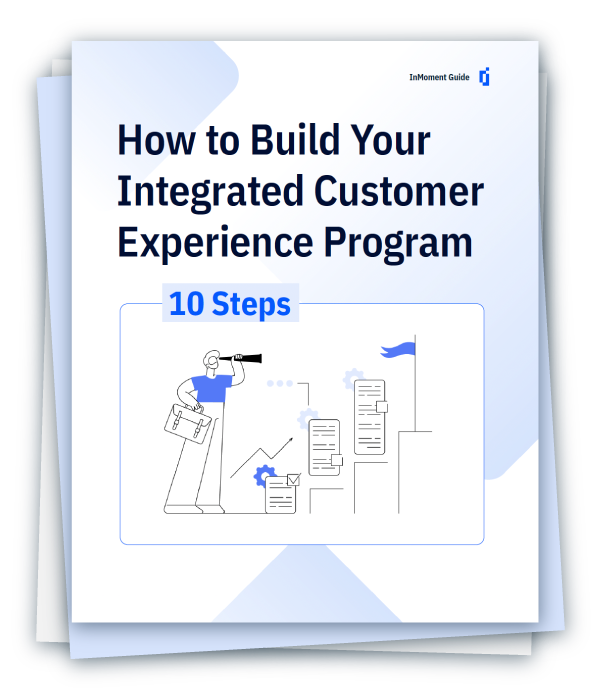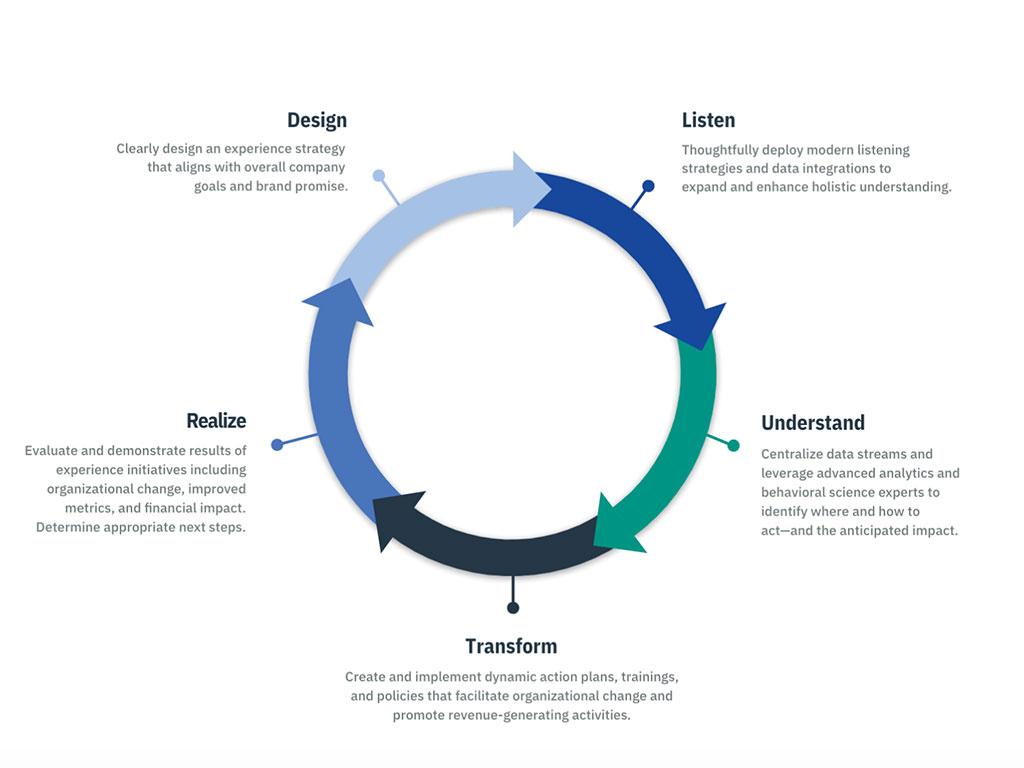
Imagine if you were still operating your business in the same way you were in 2019. Total nightmare, right? Your customer experience (CX) program, like your business, needs to be able to grow and evolve to prove a return on investment. If you’re like the majority of CX practitioners (CX Network’s “Global State of CX” report shows that it is the second highest concern for CX practitioners), you likely have quite a few ROI questions.
In our over two decades of experience helping the world’s best brands positively impact their bottom line with Experience Improvement, we’ve heard quite a few of these ROI questions, and have determined the strategies at the heart of a profitable program. In order to achieve true ROI, you need to take an integrated approach to experience by breaking down data silos and creating one ecosystem of data.
All of your customer data needs to exist in one place, where it can be accessed from anywhere in the organization, meaning that the game changing insights you need to acquire new customers, keep the old ones, expand customer lifetime value, and cut inefficient or costly processes are all in one place.
Pearl-Plaza recently held a webinar with representatives from Forrester, an independent market research firm, to give you the answers you need about your top CX ROI questions. Pearl-Plaza’s Principal CX Strategist Jim Katzman and Forrester’s Senior Analyst Judy Weader discuss showing the value of your CX program, designing digital experiences that make your business stand out, and setting your brand up for success. Let’s dive in!
Your Top 3 ROI Questions
ROI Question #1: Why Is Showing the Value of Customer Experience So Difficult?
Showing the value of your CX program can be a daunting task. How are you supposed to link improving experiences back to financial gain? Well, the truth is, most CX professionals don’t know the right mechanics they need to perform in order to show ROI through their CX program.
In order to showcase the ROI of your CX program, there are going to be calculations involved. But, don’t be intimidated by that. It isn’t as complicated as it may seem.
Let’s take a look at a call center for an example. At every call center, there is an average cost per call. For the sake of simplicity, let’s say our call center has an average cost per call of $5. If this call center receives 100 calls per day about an identified pain point (let’s say it’s a confusing process), you would be able to take that customer feedback and turn it into an actionable insight which would clarify the process, thus relieving the pain point.
By taking action, you may be able to turn 100 calls per day into 80 calls per day. 20 less calls per day at $5 average cost per call is a $100 of daily savings. Just like that, we have proved that having a CX program that creates actionable insights provides a return on investment to the organization.
Showing the value of your CX program is easiest when you are able to turn actions into numbers. By making decisions based on customer data, are you increasing revenue? Decreasing costs?
ROI Question #2: How Are Business Designing Digital Experiences That Make a Difference?
When developing a digital product or service, it’s important to think about the context that your offering will be used in. Think of your favorite airline, or an airline that has developed a “good” mobile application. The reason these apps succeed are because they were designed with the knowledge that when you check-in for a flight, you aren’t going to haul out your computer. These airlines knew it would be easier and more convenient for their customers to be able to check-in for a flight when they were on the go.
When you develop your products and services around your end customer, you’ll be able to create digital experiences that enrich peoples’ lives and generate more adoption, engagement, and advocacy.
When designing and developing your products, you also need to remember to design for accessibility. If you aren’t thinking about accessibility in your products, you are missing out on a huge opportunity. There are over a billion people in the world that are disabled. Whether it be different font sizes, text-to-speech options, or modified touchscreen shortcuts, designing for accessibility is something that needs to be done throughout the design process. It is not something that can be bolted on after the launch date.
ROI Question #3: What Three Things I Can Do to Set My CX Program Up for Success?
- Have a Good CX Vision
The optimal CX vision for your organization should be derived from your brand vision. Your brand vision should answer the question “What do I want my brand to be for the market?” Consequently, your CX vision should answer the question “What do I want my CX program to be for my customers in order to support my brand vision?”
- Build Out a CX Strategy
Developing a CX strategy can seem like a long, intimidating process. But, it is important to remember that the goal of your CX strategy is to bring your CX vision to life. If we take one more step back, your CX vision should reflect your brand vision. So, at its core, your CX strategy should align with your business goals in order to bring that brand vision to life. Using your business goals as a base, you will be able to develop an effective, focused CX strategy. Your motto should be to “design with the end in mind.”
- Align Your Priorities
You want to make decisions that are grounded in customer understanding and current business initiatives. When thinking about which initiatives to go after first, take a moment to think. What matters most to the business? What are the goals that your business is trying to achieve now versus what they hope to achieve later? By prioritizing your CX initiatives with your business goals, you will create an effective CX program.
Moving Forward
As you look forward and adopt these principles into your own ROI strategy, don’t stress about being perfect. CX programs are ongoing, ever-changing, and constantly evolving assets to your business. There is no set “right” way to utilize your CX program.
Our recommendation? Start with a quick win—a straightforward project you can measure the success of.
An ROI Example from an Pearl-Plaza Client
A few years ago, one of our clients, a national chain restaurant, was looking for a new way to get in touch with their customers. They already had an internal assessment system that was used as a comprehensive assessment of performance in front- and back-of-house operations and policies related to Food Safety, company standards, and guest experience (e.g., quality, order accuracy, speed of service, staff friendliness, cleanliness, and team engagement).
With more than 13,000 of these assessments completed each year, the results helped drive continuous improvement in quality, operations, and brand standards—but they lacked a view into the guest perspective.
This company chose Pearl-Plaza as its CX optimization partner based on its ability to interface audit data with CX data. By bringing audit and guest feedback data together, Pearl-Plaza’s prescriptive analytics automatically generated two improvement priorities for each location. The integration model takes into consideration both guest experience and audit score, and creates priorities tied to the greatest return on investment: where this organization should put more time, energy, and effort.
After implementing these data-driven improvements using the Pearl-Plaza and internal audit correlated system, the organization’s restaurants saw a significant increase in all key metrics in just eight months:
- 34% in OSAT
- 33% in Friendliness
- 22% in Product Quality
- 22% in Cleanliness and Facility
- 19% in Speed of Service
- 12% in “Make it Right” (if an order had a mistake, was it corrected?)
- 3% in Order Accuracy
By focusing on just two improvement priorities at each location, this organization was able to completely transform its relationship with its customers. Starting with small, measurable initiatives is a great way to kickstart your CX program. These small initiatives might even have results that expand further across the organization than you would expect.
If you want to learn more about extracting ROI from your CX program, watch the full webinar here!















